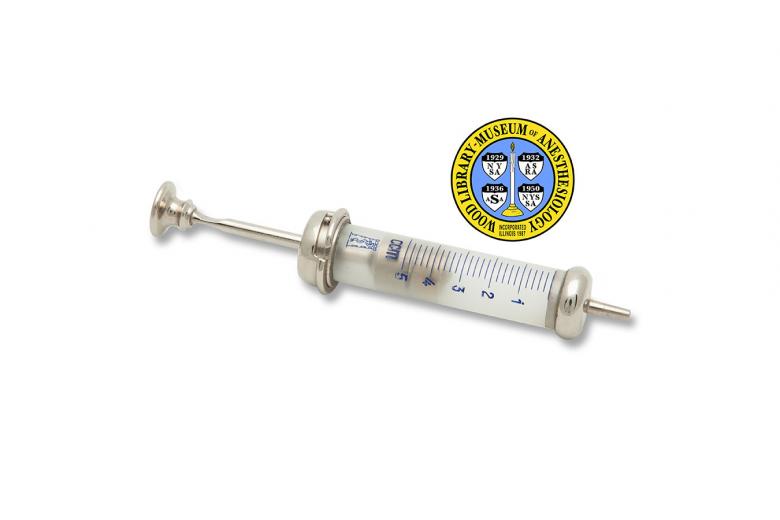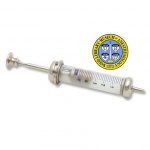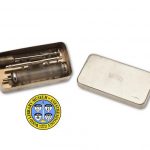Record Syringe
Regional anesthesia numbs a specific part, or larger area, of the body. Hypodermic injections of local anesthetic were first described by the Austrian ophthalmologist, Dr. Karl Koller in 1884. But 19th Century syringes were unsatisfactory.
The Rekordspritze (Record Syringe) was introduced by the Berlin instrument maker, Dewitt & Herz, in 1906. It was one of the first glass and metal syringes constructed with a high level of quality and dependability. Fluids did not leak under the plunger, it did not jam, and the graduation marks were accurate indicators of volume. It was also easy to take apart and reassemble for sterilization. At a time when the use of both asepsis and regional anesthesia were rapidly increasing, the advantages of this design made it popular with dentists and physicians throughout Europe and the United States.
It was used for procedures such as intramuscular and intravenous injections, withdrawing blood from a patient’s vein, and for the administration of local and regional anesthesia.
Catalog Record: Record Syringe
Access Key: akib
Accession No.: 1964-11-02-1 A
Title: Original Record [syringe].
Corporate Author: Dewitt & Herz.
Title variation: Alt Title
Title: Record syringes.
Title variation: Alt Title
Title: “Record” Precision Syringe.
Publisher: [Berlin] : [Dewitt & Herz], [1910-1950].
Physical Descript: 1 syringe : metal, glass ; 3 x 10 x 5 cm.
Subject: Syringes – instrumentation.
Subject: Anesthesia, Regional – instrumentation.
Subject: Anesthesia, Local.
Web Link: https://woodlibrarymuseum.org/museum/item/613/record-syringe
Note Type: Citation
Notes: Date based on the title and the latest average date that the Record Syringe
was still being mentioned with relative frequency as an instrument of current
use in published works.
Note Type: Citation
Notes: Bier’s Technic for Spinal Anesthesia. JAMA. December 22, 1906;47(25):2112.
Note Type: Citation
Notes: Brown J. The life and death of the Luer. MDDI website. https://www.mddionline.
com/article/life-and-death-luer. Published August 20, 2012. Accessed July 25,
2013.
Note Type: Citation
Notes: Frazier CH, Allen AR. Surgery of the Spine and Spinal Cord. New York: D.
Appleton and Co.:1918:850, 870, 791-792.
Note Type: Citation
Notes: Larsen MD. History of anesthetic practice. In: Miller RD, ed. Miller’s
Anesthesia. Philadelphia: Churchill Livingstone; 2010:15-16.
Note Type: Citation
Notes: Orth DA, Mueller G. A plea for spinal anaesthesia. Sait Paul Med J. July
1917;19(7):204-205.
Note Type: Citation
Notes: Surgeon’s Instruments, Office and Hospital Equipment. Chicago: V. Mueller &
Co.; 1916:254-255.
Note Type: Citation
Notes: Thoma KH. Oral Anesthesia. 2nd ed. Boston: M.C. Cherry; 1920:60-61.
Note Type: Citation
Notes: Zuck D. The Arkansas slip. Anaesth News. April, 2000;(153):8-9.
Note Type: Physical Description
Notes: Syringe parts held in a rectangular metal box (stainless steel or nickel?);
The top of the box is engraved with “ORIGINAL [new line] RECORD”; The barrel
has metal ends: at the hub and at the opening for the plunger; The metal ends
are soldered to the glass barrel; The barrel is graduated with blue marking
in .2 cc’s from 0 to 5, with whole cc’s numbered; The barrel is also marked
with “CCM” and a caduceus; The barrel, from hub to end, measures
approximately 8.8 cm in length, and 1.6 cm in diameter in the center; The
plunger measures approximately 8.4 cm in length, 1.5 cm diameter at the
plunger’s head, and 1.3 at the plunger’s tip; The head of the plunger is
engraved with the image of a caduceus and, “ORIGINAL RECORD”; The plunger’s
cap measures approximately 2.4 cm in diameter; A fourth piece, possibly a
tool for changing needles at the hub, measures approximately 7.8 cm in length
and .7 cm in diameter.
Note Type: Reproduction
Notes: Photographed by Mr. Steve Donisch on January 16, 2013.
Note Type: Historical
Notes: Syringes for medical purposes, such as irrigation and drainage of body
cavities or wounds, can be traced back at least to the time of the Romans.
Syringes with hollow needles for the injection of medication into tissue
below the skin (hypodermic) were not designed and widely manufactured until
after the mid-1800s. The syringes made during the late 1800s had a number of
problems, for example, they often leaked, it was not unusual for the plunger
to jam during injection or withdrawal, and the graduation marks could be
quite inaccurate.
Designed in 1906 by the German medical instrument maker Dewitt and Herz, the
Record Syringe was one of the first glass and metal syringes constructed with
a high level of quality and reliability. Fluids did not leak under the
Record’s plunger, it did not jam, and the graduation marks consistently
yielded the volume indicated. It was also easier than other glass and metal
syringes to take apart and reassemble for sterilization. Its main competitor
was the Luer syringe, which was made of all glass. During the first half of
the 20th century Record and Luer Syringe-types were very popular.
Anesthesiologists used them for procedures such as intramuscular and
intravenous injections, withdrawing blood from a patient’s vein, and for the
administration of local and regional anesthesia. In fact, improvements in
local and regional anesthesia are strongly tied to improvements in syringe
and needle technology.
Note Type: Exhibition
Notes: Chosen for the WLM website (noted July 23, 2013).



